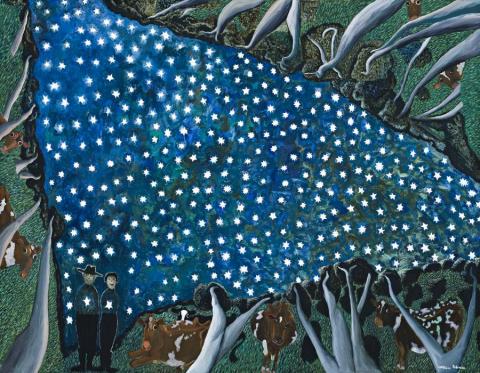BEECHMONT WITH STARRY NIGHT, 1986
WILLIAM ROBINSON
oil on canvas
99.0 x 127.0 cm
signed lower right: William Robinson
Private collection, Sydney
Fern, L., William Robinson, Craftsman House, Sydney, 1995, pp. 138–139, pl. 38 (illus.)
'To see one of Robinson's landscapes is to be in it as well, to walk, and maybe to forage, with the painter through gum-thicketed gullies where any difference between the sky and its reflection is hard to tell - and probably unnecessary to know. The viewer is required to take a leap of faith, and execute something akin to a cartwheel, before penetrating Robinson's dizzy realms. The resulting experience is partly aesthetic, partly athletic.'1
With its multiple viewpoints and fluidity between dark and light, dream and reality, close observation and imaginative interaction with the environment, Beechmont with Starry Night encapsulates well the radical paintings that heralded a significant shift in Robinson's oeuvre towards a more vigorous, individualistic style - and thus, established him as one of Australia's most distinctive and influential contemporary painters. Recognising the profundity and complexity of his achievement, certainly art critic John McDonald considers Robinson 'the only non- Aboriginal artist since Fred Williams and John Olsen to give us an entirely new view of the Australian landscape.'2
Not only is Robinson unique in his affinity with the ancient labyrinthine rainforests of the coastal hinterland of Southern Queensland - a region hitherto neglected by Australian landscape painters who had primarily turned their attention inland or inward to urban landscapes. More importantly perhaps, he subverts the powerful horizontality previously dominating landscape painting in this country by instead creating multiple perspectives through planes which recede, tilt and plunge to emulate the vertiginous scale of these uplands. Moreover, unlike the majority of his predecessors who were not painting their territory but the environment as 'other', Robinson has always felt it fundamental to immerse himself both physically and psychologically in the landscape, as he mused: 'I did not paint these works as a visitor to the landscape, but as one who lived in it and experienced it everyday' I believe I was treading a path of primary emotional experience.'3 Embodying at once an inner and outer world where both the minutiae of nature and the awesome effects of natural phenomena are explored, Beechmont with Starry Night pays homage to the universe and its benevolent creator, with the wide-eyed figures of the artist and his wife Shirley gazing in wonder at the velvety star-studded sky perhaps an allusion to Adam and Eve first marvelling at their Eden.
Celebrating the mysterious beauty of the celestial landscape which Robinson had recently discovered to be as magical as daylight in its many manifestations, indeed the work is a poetic evocation of the artist's enduring interest in the diurnal rotation of the earth and the eternal rhythms of nature; as he observes, 'Living in the country everything moves - the seasons, the clouds, nothing is set. There are things behind you, all around you and you are in it. Everything is constantly moving. You begin to realise that you are in a landscape that is really the crust of the earth. It is air and ground. We're all just spinning through space. There is something about the paintings that is indefinite, not solid. We don't really have an orientation in this infinity.'4
1. James, B., 'A Landscape We Thought We Knew', Sydney Morning Herald, 29 January 2003, p. 15
2. McDonald, J., 'The Australian landscape in a visionary's eyes', Sydney Morning Herald, 10 September 1994, p. 15A
3. Robinson cited in Seear, L., Darkness & Light: The Art of William Robinson, Queensland Art Gallery, Brisbane, 2001, p. 85
4. Robinson, interview with Deborah Hart, 2001, cited ibid., cover flap
VERONICA ANGELATOS
